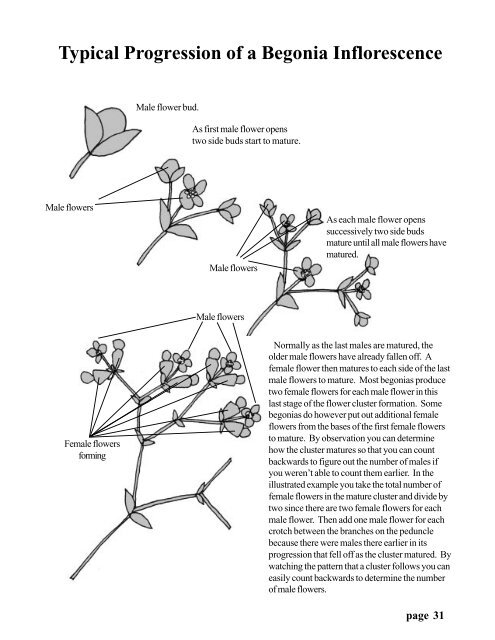Begonia Registration Handbook - American Begonia Society
Begonia Registration Handbook - American Begonia Society
Begonia Registration Handbook - American Begonia Society
You also want an ePaper? Increase the reach of your titles
YUMPU automatically turns print PDFs into web optimized ePapers that Google loves.
Typical Progression of a <strong>Begonia</strong> Inflorescence<br />
Male flowers<br />
Female flowers<br />
forming<br />
Male flower bud.<br />
As first male flower opens<br />
two side buds start to mature.<br />
Male flowers<br />
Male flowers<br />
As each male flower opens<br />
successively two side buds<br />
mature until all male flowers have<br />
matured.<br />
Normally as the last males are matured, the<br />
older male flowers have already fallen off. A<br />
female flower then matures to each side of the last<br />
male flowers to mature. Most begonias produce<br />
two female flowers for each male flower in this<br />
last stage of the flower cluster formation. Some<br />
begonias do however put out additional female<br />
flowers from the bases of the first female flowers<br />
to mature. By observation you can determine<br />
how the cluster matures so that you can count<br />
backwards to figure out the number of males if<br />
you weren’t able to count them earlier. In the<br />
illustrated example you take the total number of<br />
female flowers in the mature cluster and divide by<br />
two since there are two female flowers for each<br />
male flower. Then add one male flower for each<br />
crotch between the branches on the peduncle<br />
because there were males there earlier in its<br />
progression that fell off as the cluster matured. By<br />
watching the pattern that a cluster follows you can<br />
easily count backwards to determine the number<br />
of male flowers.<br />
page 31


